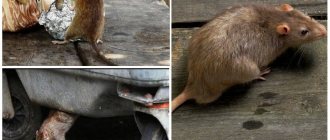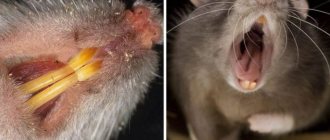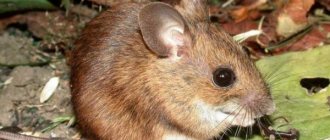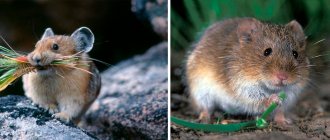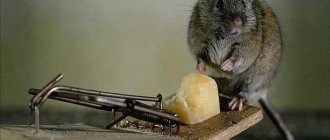In the fight against mice, one of the main success factors will be the correct choice of bait. After all, animals need to be lured into any trap - a mousetrap, a live trap, or glue. Baits can simply attract rodents, or they can hide poison. In any case, the bait should be such that the pest loses caution and follows it into the trap.
What products will be considered by mice as the best bait?
Plant-based treats
It is known that mice like plant foods, since in nature the animals’ diet consists of grains, tree bark, seeds, fruits, and berries (they can snack on all the strawberries in the garden beds). Snacks of animal origin (snail or slug) are consumed much less frequently by rodents in the wild.
Therefore, if the goal is to catch a mouse, then they lure the animal with fruits and grains:
- a piece of apple, plum, as well as apricot, peach, pear;
- fresh crust or crust of bread (it is better to moisten the bread with vegetable oil);
- spoon of porridge.
Mice leave their shelters to look for food up to 30 times during the night. So there are plenty of chances to catch them.
By the way! How do you make sure that the target object is a mouse and not a rat? And why is it important to know who is being hunted?
Mice love fresh bread soaked in vegetable oil (it’s better to take unrefined bread: it smells stronger). Pests may like sunflower oil, but they really love sesame oil: when they smell it, the animals lose all caution.
In addition to black bread, baked goods, sunflower seeds and other grains .
Important! If you don’t mind putting a bun or other baked goods in a mousetrap, then it should be fresh and fragrant. These animals will not take risks to eat a stale bun.
Muffins or bread have a dense consistency - this is an excellent bait for mice in a mousetrap: it is convenient to place on the trigger. The baked goods emit a strong odor, enough to make the rodent forget about caution.
Corn
Roasted seeds or rice, wheat, barley, any cereal, oatmeal cookie crumbs poured into a trap act like a magnet on pests. However, such products cannot be caught on a trigger - they are simply placed in a trap or poison is prepared from them by mixing in toxic substances.
Interesting! Traps that work without a hook are divided into three types: live traps (then you need to go farther from the house to release the animal), traps with poison, glue traps, and those that kill with an electric discharge. From a humane point of view, live traps are the most preferable: it is simply an enclosure in which mice remain completely unharmed and can also satiate their appetite. It is with such live traps that the most humane citizens begin their fight against rodents. But having received a couple of mouse surprises in the form of spoiled food or a burned-out system unit due to chewed wires, they say goodbye to illusions and move on to killing traps.
Fact! When dealing with mice, the first thing you need to do is make sure that you are dealing with them. Mouse gnawing marks and feces are similar to those left by young rats. These pests have different tastes, powers of smell, intelligence, and therefore their favorite treats. It is advisable to quickly catch at least one animal in order to recognize the enemy by sight.
Peanut butter
Make small balls from it or spread oil directly onto the working surface of the trap. Catching rodents using this product will be effective.
Interesting! Cheese is not a priority for mice. They do not secrete this product and rarely go into traps for it. After all, in nature, rodents have nowhere to get lactic acid food. Although some believe that pests are still susceptible to particularly odorous varieties of cheese.
Tips for choosing a ratcatcher cat
- First of all, you need to consider that the rat is a major pest. Only an animal of the appropriate build can cope with it. You should not expect that a small, fragile cat like the Singapura, weighing only 3-4 kilograms, will risk taking your side in this dispute. A ratcatcher cat should have a strong, stocky body and powerful jaws. Body size should depend on muscles, and not on fat - a plump cat only looks impressive, but in reality it is unlikely to bite a mouse.
- Most often, the ability to fight rats is demonstrated by the “weaker sex” – cats, not cats, contrary to popular belief. There is an opinion that this is due to the protection of offspring, because rats are very dangerous for a small kitten. Be that as it may, in nine cases out of ten, the purr with the gray pest in his teeth is Murka, not Vasily.
- If we talk about the breed of the future assistant, those called aboriginal or natural are suitable. Such breeds have evolved over centuries without human intervention, often descended from wild ancestors and inherited hunting instincts. These include, for example, the Siberian cat, the European shorthair, and the Siamese. However, the most effective are considered to be yard, outbred purrs - for the reason that they have to fight for life, and the strongest and most skillful individuals survive. Of course, you shouldn’t expect that any fluffy dog on the street is an excellent rat catcher. Most often, homeless wanderers are former domestic cats, kicked out by careless owners.
- To avoid mistakes and almost certainly get a rat-catcher cat, you should look for a kitten born to a rat-catcher mother. Firstly, since the mother cat has suitable data for such work, then they will certainly be passed on to the children. Secondly, hunting plays a big role in raising kittens, and the cat will definitely teach them the wisdom of fighting rats. Of course, the information that this cat catches rats must be verified. And of course, there is no need to rush to take kittens away from their mother before they have yet learned this complex art.
Remember that if your pet is bitten by a rat, you need to immediately help him, it is best to contact a veterinarian. To protect your cat from possible infections, you should get all the necessary vaccinations in advance, and be sure to treat the wounds.
Author of the article: Alena Oleynikova, artist and cat lover, especially for Kota Obormot
Treats of animal origin
Mice living in the city, unlike their sister voles, are omnivores and willingly eat animal food.
A small piece of lard is the leader among mouse baits. To enhance its attractiveness, one edge of it is fried with a burning match - the smell becomes intoxicating. You cannot use old lard or take a rancid piece : pests will not fall for this.
Important! This decoy is also good for rats. If it is not clear who spoils food in the house - mice or rats, baits should be selected so that they attract both types of rodents, at least until the situation is clarified. Another life hack: put two baits in the trap: one designed for mice, the other for rats.
Sausages
Modern sausage is not such a suitable option for rodents; after all, unlike people, they have not learned to eat food stuffed with artificial additives. If you want to equip a mousetrap with a circle of sausage, then you will need a high-quality product that is as chemical-free as possible.
Mole
Another animal that a person tries with all his might to expel from his plot is the mole. Unlike rats and mice, it does not feed on the roots of the plants under which it digs. The mole belongs to the insectivorous mammals.
His favorite “delicacy” is earthworms. But he will not refuse to eat insect larvae that harm cultivated plants. So in some sense it even brings benefits. However, constantly digging tunnels in search of food, the mole turns out seedlings, undermines the roots of plants, and its hummocks spoil the appearance of the lawn and beds.
The mole prefers to live on fertile soils, where it is easier for him to find food, because per day this animal eats as much as it weighs.
Unlike mice and rats, moles reproduce once a year. At the end of May - beginning of June, the female gives birth to from three to nine cubs. And already at the end of June, young diggers, having left their parental hole, begin to dig their own tunnels.
There are many ways to force moles to leave the place they inhabit: from folk methods to the latest technical innovations.
- Is it possible to drive moles out of the garden forever?
Moles annually cause incredible damage to summer cottages. Is it possible to prevent the dominance of these harmful mammals?
Baits for preparing poison
There are delicacy baits (for trapping, luring into live traps and electric traps) and poisoned baits. For one type or another, you need to choose the right products. Thus, the base for the poisonous filling must be mixed with the active substance until smooth.
The bases for preparing mouse poison can be porridge, dough, mashed potatoes, flavored with sunflower or sesame oil. Toxins are mixed with them - Ratid, Zookoumarin, Ratindan.
Interesting! Zookoumarin and Ratindan are poisons based on anticoagulants. They are considered long-acting poisons. The mouse dies from internal bleeding, but this lasts from three days to two weeks. At the same time, the toxin causes suffocation in the animal, so it tries to leave the room for air. However, there is no guarantee that the mouse will not crawl to die in some deep passage, where its corpse will subsequently exude a disgusting smell. Therefore, it is better to place poison with Zookoumarin in traps to block the pest’s path to escape. Ratsid is a fast poison; rodents die from pulmonary edema right at the site of eating the poison. However, mice and rats quickly learn and begin to recognize this poison and eventually refuse the bait.
Also, the food base can be beer (mice love it very much, and rats won’t pass it by), raw fish or minced meat, or a boiled egg (finely chopped).
The more fragrant the base of the poisonous bait is, the more reliably it masks the smell of the toxic substance. However, beer requires the use of additional containers (bowls), which is not entirely convenient. Therefore, the number one basis for making poison will be raw minced meat. In second place are porridges and purees seasoned with sesame oil .
A toxic agent is added to the base in doses corresponding to the instructions. The finished poison is placed in a trap, and the liquid poison is placed in a saucer.
When preparing poisonous bait, you should wear thick rubber gloves. This is necessary not only to protect your hands, but also to prevent human odor on the bait (one of the main mistakes when fighting rodents).
Of course, it is much easier and safer to buy ready-made mouse bait in a special store than to bother with homemade poisons. The assortment is varied: granules, poisonous grain, dough briquettes. There are ready-made poisons for rats and mice.
All that remains is to fill the traps with poison.
Important! Traps are placed along the path of rodents. They walk along the perimeter of the room, along the walls, but do not cross the center. Mice do not travel far from their shelters; twenty meters is the maximum range of their travel. Taking this into account, traps are set. Another useful feature of the mouse character for humans is that they are curious, so any new object in the feeding area attracts the attention of them and the rodents themselves.
Poison baits are a good way to catch and punish pests, but they are not ideal. Because, after all, the risk cannot be ruled out that a dying rodent will go deep into its shelter and die there, subsequently emitting a corpse odor.
Interesting! More preferable electronic traps are now available. They are also equipped with baits; the attracted animal comes inside and is instantly killed by electric shock. No pain, no smell, no blood. Charging the device lasts for 100 strikes, which is suitable for food warehouses and large production areas. However, the devices are quite expensive and cannot be used outdoors unattended (due to the threat of rain).
Mice and rats
These petty thieves have been living next to people for many centuries. They destroy crops, damage property, and spread infections. The mere fact that a rat eats from 7 to 10 kg of food per year, and spoils and contaminates 10 times more food, already speaks volumes. And if we take into account their fertility (they produce from 2 to 6 litters per year), then the damage is much more significant.
Rats and mice are polyphagous rodents. In the summer, in the garden or greenhouse, traces of their incisors often appear on carrots, beets, and other root vegetables. Sometimes they eat away entire cavities in vegetables and fruits. And their passages and holes dug in the ground lead to the formation of voids at the roots of plants, because of which they begin to wither and die.
In winter, rodents move from gardens into houses and sheds, creating a terrible mess there and destroying crops stored for storage. Those pests that remain to winter in their burrows eat the bark of fruit trees and shrubs, which negatively affects their growth and development.
The central zone of the European part of Russia is mainly inhabited by house and field mice, gray and black rats, which differ in body size, tail length and color. But they cause similar harm.
Over so many years of “neighborhood”, people have come up with many different ways to combat these rodents.
- How to get rid of mice forever in your house, apartment and country house
What to do if there are mice in the house? Find out now.
But the final victory over mice and rats is still far away.
About enemies
Almost the entire Northern Hemisphere is inhabited by wild field mice. Most of the subspecies of this family live in open landscapes, using grain crops and agricultural plants for food. Shellfish and various insects can also serve as food for rodents.
Small rodents are very prolific: within a year, the size of the mouse population increases several times. Thanks to intensive reproduction, mice become easy trophies for various animals.
Field mice and their enemies
Wild species of rodents - field mice inhabit almost all continents and islands of the Northern Hemisphere and have many different subspecies. Most of them prefer to live in open landscapes in a temperate climate, where they find food for themselves: grain crops and many parts of plants (tubers, bulbs, etc.), sometimes they eat mollusks and insects.
Due to their enormous fertility, small rodents reproduce very intensively; their population can grow several dozen times in a year. The widespread distribution of these rodents makes them quite accessible prey for many species of animals. They are most active at night, when they are attacked by their enemies: birds of prey and animals.
Who eats mice living in the wild? First of all, these are foxes, martens and weasels, for which mice constitute the main diet. They are caught and eaten by ferrets, who consume 10-12 voles per day, and weasels, thanks to their long and narrow body, can even sneak into mouse holes and eat small mice. Wolves, lynxes, mongooses, arctic foxes and other predatory animals also feed on rodents in the absence of other larger prey.
Animals that eat mice
Voles and foxes love to eat. In winter, rodents constitute the only diet of foxes. Moreover, the number of foxes in the population often depends on how many mice the fox eats during these months.
Another key enemy of mice is birds of prey: owls and owls, which are capable of destroying up to 1,200 rodents each year. Owls catch mice and eat them whole, along with bones and fur, due to their specific digestive system.
The owl usually hunts mice at night. Sometimes birds such as the raven or the shrike are not averse to eating mice.
On a note!!
Owls hunt rodents not only for their own food, but also to feed their chicks: the life of the younger generation and its normal development sometimes depend on the number of mice caught by the mother.
Natural enemies of field mice in nature are also forest and domestic cats (especially if there is human habitation near the rodent’s habitat), hedgehogs and snakes. For hedgehogs, a rodent is not an everyday food, because... It's hard for him to keep up with him. Hedgehogs eat mice if they get in their way.
Interesting!
Among snakes, the biggest fans of eating mice are vipers and snakes. For them, these rodents are their main food. The viper goes out hunting every night; it catches mice and eats them, swallowing and digesting them whole. Also, these snakes often use burrows and passages dug by rodents as housing. Large lizards also eat mice.
Cats
Another one that eats mice is the lynx. In the absence of larger prey, the predator is able to satisfy its appetite with several rodents.
The body length of the animal, which belongs to the cat family, is about a meter. The lynx is distinguished from a cat by its graceful ears with tufts and hard rumps framing its muzzle. A distinctive feature of the predator is also its short, stubby tail.
Weasels and martens
In addition to cats, martens and weasels eat mice. In addition, they do it much faster and more efficiently, because mice are the main diet of animals. In the housing where the weasel hunted, the rodents disappear within 5-7 days.
Weasels are very active and nimble animals that, despite their cute appearance and small size, keep even larger animals at bay. The body length of predators is 20-22 cm. The long narrow body of a predator makes it possible to easily penetrate a rodent burrow and eat a vole or wood mouse hiding there.
The animal has an attractive white (in winter) and brown-brown (summer) coat, a slightly narrowed head, small ears and a muzzle. Distinctive features of the weasel are large dark eyes and a long tail, under which there are glands that secrete a specific pungent odor. It is thanks to this aroma that the animal scares away other predators.
The marten is no worse at hunting mice. The representative of the large family of mustelids has thick soft fur, colored in dark brown or brown-chestnut tones. The length of the slender, slightly elongated body does not exceed 55-58 cm. The distinctive characteristics of the agile animal are a yellow round throat spot and a fluffy tail, the length of which can be almost half the length of the marten’s body (16-28 cm). The predator has very short five-fingered paws with claws.
How do rats live and what do they usually eat?
Rats eat not only plant foods, but also meat
Rats live almost anywhere there is food, as their main goal is food for survival, reproduction and distribution. That is why there are so many rats in any country and in any city. Typically, these rodents hide in shelters during the day (basements, crawl spaces, crevices, abandoned buildings), and go out hunting at night. Rats can organize entire colonies and settlements. These rodents easily master new territories, but if they find a good place, they can settle there. In this case, when trying to drive them away from the inhabited territory, they can actively resist and fight for their home.
As for nutrition, rats can be called not only omnivores, but also predators. Firstly, they enjoy eating plant foods, for example, leaves and stems of plants, grains, and seeds. Secondly, they can eat waste (which is why such pests often settle near garbage dumps) or even materials that are completely unsuitable for food, such as rubber, paper, wires, and so on. Thirdly, rats have a need for animal protein, which means that they can and even should eat meat.
Ferrets
Ferrets and foxes eat mice
Stocky with a flexible, elongated body, the animal has disproportionately muscular short legs, which allows them to move by jumping and swim perfectly. Long, strong claws on the fingers make it possible to dig deep holes and deftly climb trees. They are used to catch ferrets and mice.
The ferret's body length is about 50 cm, the animal has a flexible neck, an oval head and a slightly blunt muzzle towards the nose. The fluffy tail is a source of pride for the animal (in adults it can reach up to 20 cm). Near it there are special glands that secrete a specific secretion with a pungent odor.
The thick fur covering the animal's body is lighter at the base and darker in color at the tip. It is especially beautiful after the autumn molt, becoming more silky and shiny. The animal's color range can vary from light sand to almost black tones.
Plants
The mouse is an object of hunting not only for predatory animals and birds. Nepenthes spathulata is a plant that eats mice. This plant predator belongs to the insectivorous family and grows on the islands of Sumatra and Java. It is a stem on which there are many pitcher flowers. They emit a sweet floral scent that attracts insects and small mammals. An approaching mouse is absorbed by the flower thanks to its slippery surface, due to which the rodent is no longer able to get back out.
The length of this unique plant can reach 5 m. Like owls, the plant predator swallows insects, rodents and other small animals whole. The bones, teeth and fur of the victim are digested thanks to special digestive enzymes.
We often spend a lot of time learning what mice eat so that we can use traps as effectively as possible. It is also important for us to store these products correctly so that mice cannot get to them. But what predators like to eat rodents themselves? It’s easier to ask: “Which animal does not eat mice?” After all, it looks like most of them would happily eat a mouse for lunch. After all, what living creature with a beak, claws and sharp teeth would not want to catch animals that are found in large numbers almost everywhere. Mice are one of the most common “snacks” in the animal kingdom.
Who eats house mice?
House mice have been living in houses or close to human habitation for many centuries, feeding on food or plant food that they find near habitation.
The main competitors of domestic mice are gray rats; they also try to settle closer to humans and often kill and eat their small brothers.
People who have small rodents in their home try to get rid of them as soon as possible, because... Not only can they eat food, but they also contaminate it with droppings and urine, creating a specific odor, and damage furniture and other household property. In garden plots, they destroy part of the crop, damage the bark of trees, spoil crops and the supply of vegetables for the winter.
The most common way to help a person get rid of rodents is to get a cat that catches mice. Although not all cats eat mice, most have a hunting instinct. In addition to cats, some breeds of dogs (fox terriers, dachshunds, huskies, Yorkshire terriers, etc.), as well as domestic ferrets, which have become fashionable over the last decade, can catch rodents. These animals, as in the wild, love to hunt rodents, even if they live in an ordinary city apartment. Ferrets catch mice and rats, and can also hunt other small animals and birds that find themselves in the house.
Some dog breeds were specially bred to hunt rodents. Now known as a decorative sofa breed, the “Maltese” was a constant companion of the Knights of Malta, who kept these dogs on sea ships specifically to fight rodents.
Read also Video of a road trip to the south August 2021
The role of mice as food for other animals cannot be underestimated, because these rodents are a very important link in the food chain of many predatory animals, for many they are the main source of food.
We often spend a lot of time learning what mice eat so that we can use traps as effectively as possible. It is also important for us to store these products correctly so that mice cannot get to them. But what predators like to eat rodents themselves? It’s easier to ask: “Which animal does not eat mice?” After all, it looks like most of them would happily eat a mouse for lunch. After all, what living creature with a beak, claws and sharp teeth would not want to catch animals that are found in large numbers almost everywhere. Mice are one of the most common “snacks” in the animal kingdom.
Famous rodent lovers
What animals do mice fear the most? Although some of the larger tarantulas feed on rodents, they are not traditional prey for most spiders. Rather, for them mice are something like a dish for a rare snack. The diet for tarantulas mainly consists of insects. But there are many animals that eat mice daily and thus control the rodent population. Birds of prey such as eagles, hawks and owls view mice as a common food source. The heron, crow and blue jay are not birds of prey and will also easily eat rodents if they can find them.
In addition, some reptiles also like to feast on mice. Large lizards are known to eat small animals. Snakes also consume mice as their main source of food. People who keep them as pets take into account the snake's preferences and try to feed them rodents. Often frozen rather than live mice can be found on sale for such pets, since owners do not always want to see a snake devour a live animal.
When it comes to mammals, cats are undoubtedly the most famous rodent catchers. But indoor cats won't necessarily eat mice once they're done "playing" with them. This is more common with their wild cousins, who hunt mice more actively to feed on them. And big cats, such as lions, tigers and jaguars, need more filling meals, but, nevertheless, sometimes they are not averse to snacking on small animals. In some cases, dogs may eat mice to survive. Your pet dog may not hunt rodents, but wolves, foxes, jackals and coyotes definitely will.
Baking, cereals
Bakery products occupy an honorable third place in our TOP. To enhance the alluring effect and stimulate the rodent's appetite, a piece of bread is generously moistened with sunflower oil.
The baked goods should be fresh, fragrant and extremely fragrant with an admixture of bran or whole grains.
An excellent bait for mice in a mousetrap can also be made from sunflower seeds or seeds of grain crops: sunflower, wheat, buckwheat, rice, etc. It’s even better if the grain is treated with some kind of rat poison: if the trigger mechanism doesn’t work, then the animal will die from poisoning anyway.
Don't risk your pet
Despite the fact that there are quite a large number of animals that will happily eat a mouse that has settled in your home, it is not advisable to let your pets near rodents.
Mice are capable of carrying parasites and various diseases that can lead to dire consequences. So, instead of risking your animal's health and yours, invest in a reliable Victor® mouse trap that will do the unpleasant job for you. The company can offer exactly what you need!
Salo
Let's put lard at the top of the list. It has been noted that a fragrant piece of freshly smoked or salted lard literally attracts hungry rodents like a magnet. It is not surprising that such mouse bait has been successfully used for hundreds of years.
Helpful tips for use:
- You shouldn’t put old, rancid bacon in a mousetrap - it’s unlikely that such a piece will be to the delight of a pest;
- You can increase the effectiveness of the delicacy using a cunning trick: fresh lard, “fried” with a match, lures voles tens of times more powerfully.

